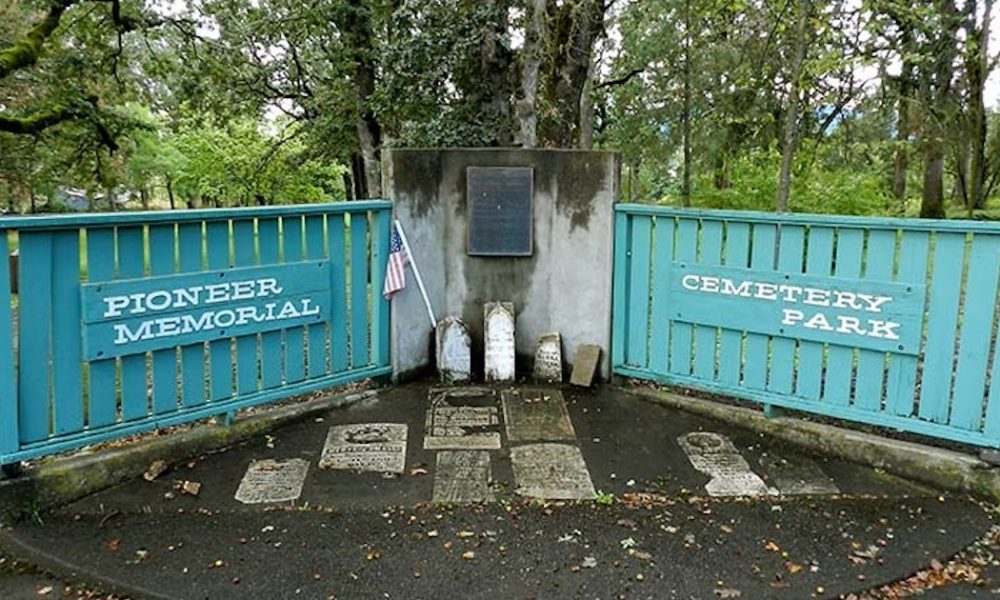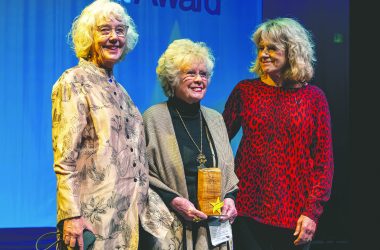 Pioneer Memorial Cemetery Park, a public park containing the remains of early residents of Springfield. Elias Briggs founded and named Springfield in 1848. He delivered the cemetery deed to trustees on Oct. 31, 1866. Briggs died in an insane asylum, Oregon State Hospital, on Jan. 17, 1896, though he is likely not buried at the park, but instead on the hospital grounds. VICTORIA STEPHENS/THE CHRONICLE
Pioneer Memorial Cemetery Park, a public park containing the remains of early residents of Springfield. Elias Briggs founded and named Springfield in 1848. He delivered the cemetery deed to trustees on Oct. 31, 1866. Briggs died in an insane asylum, Oregon State Hospital, on Jan. 17, 1896, though he is likely not buried at the park, but instead on the hospital grounds. VICTORIA STEPHENS/THE CHRONICLE
SPRINGFIELD – For being the oldest cemetery in Lane County, the file on Pioneer Memorial Cemetery Park is notably thin.
Aside from a few old newspaper articles, a page in a booklet and a plaque at the park’s entrance, information on this park at 398 S. C St. is scarce, said Jennifer Marsh, Willamalane’s adult programming and living history coordinator.
Is Pioneer Memorial Cemetery Park a cemetery or a park? Uniquely, it is both, and through a piecemeal of information, the story goes something like this:
* * * * * *
The cemetery land was in use as early as 1852 and was used for burial purposes until 1900.
Elias Briggs – who founded and named Springfield in 1848 – and his wife, Mary, delivered the cemetery deed to trustees Harvey Small, Edwin Powers and T. J. Brattain on Oct. 31, 1866.
The first Christian church in town was originally built on a portion of the cemetery lot, but was later moved to 4th and North A streets – the current location of the PublicHouse. After the church was relocated, the trustees sold the cemetery land to Mattie A. Chezem in 1907.
On April 1, 1913 the land was purchased for $50 by M.D. Copenhaver.
A few months later, the City of Springfield filed suit in Lane County Circuit Court to regain the property. A poor legal description was cited as one of the problems with transferring the land. Because of this, the City claimed the church had never owned the property and therefore couldn’t sell it.
At the time, Springfield City Council described Pioneer Cemetery as ”a place that had degenerated into overgrown open pits where bodies had been exhumed, graves unprotected and foot and wagon trails crossed the property with no regard for the graves therein” and as ”a resort for lewd and indecent persons, for illegal practices and the commission of offenses against public decency.”
That being the case, Council closed the location to further burials and instructed relatives of those already buried there to remove the bodies within 60 days.
By then, the cemetery had become overgrown with blackberries and according to council, ”had become a menace to the health, morals and public decency and a disgrace to the town of Springfield.”
Most of the bodies were eventually relocated to the Laurel Grove Cemetery in Glenwood, according to Marsh.
On June 26, 1915, Council recommended that the cemetery be fenced off and, until 1973, it was closed to the public.
During those nearly 60 years, very little was done to maintain the property.
In 1966, Springfield City Council discussed removing and preserving the remaining bodies, when the president and general manager of Springfield Memorial Gardens, Lowell J. Rhoden, offered to relocate the remaining corpses to his cemetery. Gary Buell, another Springfield funeral director, agreed to supervise the exhumation and reburial without charge.
However, City Attorney Ed Harms Jr. said it was still unclear who legally owned the land and advised against it. Further, the expense of doing so was so prohibitive that Council ultimately elected to leave any remaining corpses in place.
On Feb. 7, 1973 the City began the Pioneer Memorial Cemetery Park beautification project. At the time of the project only 12 damaged tombstones remained – the remnants of which make up the entry memorial of the quarter-acre public park.
Twenty-one graves are still listed as being located on the site, but because of vandalism and lack of maintenance for more than half a century, it is not known how many individuals were buried in the cemetery-turned-park.
”It is likely there are other plots on the property,” said Paula Guthrie, commissioner of the Springfield Historical Commission said.
* * * * * *
These days, the site itself is rather remote and isolated.
The entrance features an ominous collection of broken tombstones – cracked, with missing pieces, largely illegible with age – embedded in cement at the base of the front sign. These are the only traces of the park’s history as a graveyard; over time, all other headstones were removed, vandalized or stolen.
Walking along the property, there is a trailhead at the back side of the park/cemetery, at the east end of the Booth-Kelly Center parking lot.
Marsh said the Tomseth House, which used to be located across the street from the park, was home to the first superintendent of the Booth-Kelly Mill, and that he would walk from his house through the cemetery to the Mill. The Tomseth House was moved to its current location at Dorris Ranch in 1996.
The park is still owned by the City of Springfield – unusual given that Springfield has its own separate taxpayer-funded Willamalane Park and Recreation District, which owns all the other parks in the City. Willamalane also manages and maintains this city-owned historical park.








